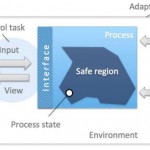BY René Ahn, Emilia Barakova, Loe Feijs, Mathias Funk, Jun Hu, Matthias Rauterberg
 We cast a design view on the interactions that occur when humans face (interconnected) adaptive systems. As humans are also adaptive, the combined behavior of such systems and humans can exhibit various phenomena that are especially of concern to designers of adaptive systems dealing with the inherent complexity of systems, systems’ interfaces, interconnectivity, and other design factors. Based on examples of interactions between humans and systems at different levels of complexity, we propose a hierarchical taxonomy of increasingly complex challenges that system engineers will encounter when designing adaptive systems. Among adaptive systems, the taxonomy distinguishes closed and open systems, embodying processes that are unaware or aware, and finally, friendly and hostile. This taxonomy can be of use in designing these systems and their interfaces, as it helps to categorize the information needs of users. In fact, systems at various levels in the hierarchy need to offer certain cognitive affordances for users to operate these systems successfully. We illustrate how complex the information needs of users in these different situations can be, and formulate emerging design research questions. These could be of particular interest to designers who create intelligent systems, products, and related services in a societal context.
We cast a design view on the interactions that occur when humans face (interconnected) adaptive systems. As humans are also adaptive, the combined behavior of such systems and humans can exhibit various phenomena that are especially of concern to designers of adaptive systems dealing with the inherent complexity of systems, systems’ interfaces, interconnectivity, and other design factors. Based on examples of interactions between humans and systems at different levels of complexity, we propose a hierarchical taxonomy of increasingly complex challenges that system engineers will encounter when designing adaptive systems. Among adaptive systems, the taxonomy distinguishes closed and open systems, embodying processes that are unaware or aware, and finally, friendly and hostile. This taxonomy can be of use in designing these systems and their interfaces, as it helps to categorize the information needs of users. In fact, systems at various levels in the hierarchy need to offer certain cognitive affordances for users to operate these systems successfully. We illustrate how complex the information needs of users in these different situations can be, and formulate emerging design research questions. These could be of particular interest to designers who create intelligent systems, products, and related services in a societal context.
FULLTEXT: PDF REFERENCE: BibTeX EndNote
DOI: 10.11648/j.acis.20140204.12